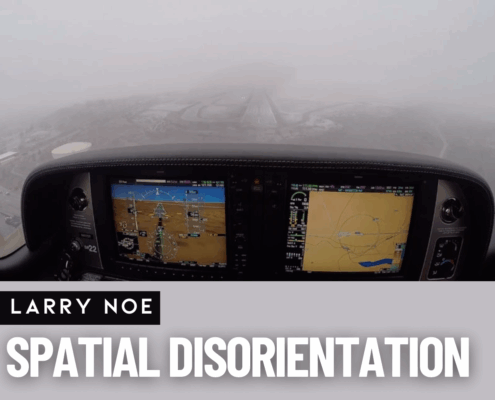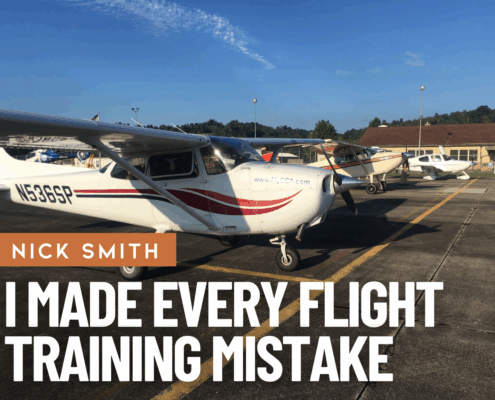
Spatial Disorientation: I Thought It Couldn’t Happen to Me
I Can't Believe I Did ThatI began climbing to get between layers, intending to stabilize and then request IFR. But as I entered the clouds, what I thought could never happen did. I was in an unusual attitude: 45 degrees banked and nose down. For a moment, I considered pulling the CAPS parachute. I had often wondered if I’d have the presence of mind to use it in a real emergency. After this, I know the answer is yes. But I also realized I could recover.

I Made Every Flight Training Mistake Humanly Possible
I Can't Believe I Did ThatFlight training is rarely a straight line, but for Nick Smith it turned into a winding, four–year journey full of delays, false starts, and unexpected costs. In this brutally honest account, he shares the mistakes he made—so future pilots don’t have to repeat them. His story is both a cautionary tale and a reminder that perseverance can still lead to the certificate.

A Quarter Tank and a Prayer
I Can't Believe I Did ThatI was watching the fuel gauges drop before my eyes. I elected to continue to ECG rather than turn back. I was on a direct course. The Norfolk controller wished me luck—not the most reassuring sign—and handed me off to ECG Tower, who had already been briefed.

Trial by Ice
I Can't Believe I Did That, I was thereThe most valuable lesson I learned from the “School of Hard Knocks” had nothing to do with weather or instrument flying. The “trial by ice” was a lesson in the awesome responsibility that comes from occupying the left seat of an airplane, regardless of its size. It also taught me to recognize those rare and unusual emergency situations when going by the book is not safe, and when deviating from standard operating procedures or the Federal Air Regulations is not only warranted, but imperative.

I Am UNSAFE Checklist—Lessons Learned on a Fateful Night
I Can't Believe I Did ThatVery soon I was on the approach and thought I could still make 06C. The ATIS called out the overcast at 800’ AGL, the minimum I needed (mistake #5—not mine, but it counted anyway.) I held at 800’, assuming I’d see the runway lights below me and then I could continue to 06C. As I crossed the runway threshold, it was solid IMC and I had to go missed. I asked the Tower what the current ceiling was, and the response was that the ATIS was old and the ceiling was actually 400’ and you’ll have to go around.

The Arrogant Pilot
I Can't Believe I Did ThatOn one early Monday morning, I took things for granted. I cut corners. I made certain assumptions about a departing fuel truck and an obscured fuel gauge—no substitute for pilot responsibility. Thirty minutes later, barely clearing the redwood ridge tops of the Santa Cruz mountains, I would dive for the first straight section of road I could find in the Silicon Valley.

How I failed my IFR Practical Test Twice
I Can't Believe I Did ThatI decided after two attempts to not take the Instrument practical again. The examiner was gracious and realized that, being over 55, I did not have plans for commercial flying and certainly not airlines (ATP). He reminded me it is not easy to stay current with an Instrument Rating and flying IFR by yourself can be challenging even for the most proficient pilot, especially if you do not have an autopilot.

The time when I almost landed short
I Can't Believe I Did ThatThe plane was perhaps 50 feet above the ground, but at least there was a smooth gravel under-run and the wheel pants were off. I had just enough energy to flare with a soft touchdown. I prepared myself for landing short. What an embarrassing end to the second leg of my Private pilot solo long cross-country.

Centerline, centerline, centerline
I Can't Believe I Did ThatThe gusting wind from the east returns, pushing the aircraft toward the right side of the runway. In a matter of a few seconds, the grass infield fills my windshield. I didn’t get the thumb into the wind and I didn’t immediately get on the left rudder pedal to steer us back to the centerline. Years of training ignored in an instant which means we are now headed into the infield.

A dead stick landing and a chance encouter with Hal Shevers
I Can't Believe I Did ThatAt about 1,500 feet hawking the wind sock to determine my landing runway. The UNICOM frequency was quiet and I saw no other planes in the pattern. I turned away to re-enter on a 45 degree downwind. As I banked back to the field came a startling assault of silence. The engine quit—politely and with no shudder—it simply stopped running. I was a glider.

Quick land to Quicksand
I Can't Believe I Did ThatThe landing went smoothly. As I taxied the Cub toward where I wanted to park, we hit a patch of quicksand that I hadn’t spotted from the air. Within the blink of an eye, the bushwheels sank, bringing the plane to an abrupt stop and sending its propeller into the sand and tail into the air.

Lessons learned from a sloppy IFR/VFR approach
I Can't Believe I Did ThatLowering the Mooney’s nose for descent enabled me to finally see the runway. However, when my bird’s nose is lowered, she is so slippery I accelerate quickly at the very time I need to be slowing. I intercepted the approach course and then flew through it.

Watch out for TFRs
I Can't Believe I Did ThatSuddenly, my peripheral vision picked up something to my left and the serenity of the morning was shattered. A Black Hawk helicopter was a few feet off my wing! As I stared at it in disbelief, the door slid open and a soldier in fatigues held up a large 121.5 sign. My shaking fingers stabbed at the radio 'emerg' button and I managed a feeble “hello?

Two in a row—a chain of mistakes and lessons
I Can't Believe I Did ThatWith less than 30 minutes to go before arriving, the battery couldn't hold a charge anymore. A warning message popped up on the PFD, and it only took five minutes for the electrical system to shut down. Thankfully, the PFD has a backup battery, so I knew I had around 30 minutes before it would go dark. I also had a Sporty's backup radio in my flight bag.

My self-taught Immelmann for collision avoidance
I Can't Believe I Did ThatThe speck eventually sprouted a fuselage, twin-engine nacelles and a T-tail. By the time the wing panels outboard of the engines became big enough to see, along with the turbine exhaust pipe exiting the near side nacelle, I was measuring four G’s on my panel accelerometer and depressing my control stick microphone switch.

Unfamiliarity and distractions nearly result in a gear up
I Can't Believe I Did ThatAbout that time, another beeping noise could be heard over the buzzing in my headset. “What’s that?” I asked. “I’m not sure,” was the reply. Now we were about a mile and a half from the runway. Thankfully Philip did his GUMP check. Gas, undercarriage. Then we both noticed where that other beeping noise was coming from.

Caught above an overcast layer results in first encounter with IMC
I Can't Believe I Did ThatBy the time I did a 180 degree turn, there wasn’t a spot of open ground to be seen from horizon to horizon. At this point in my training, I didn’t even know what an approach plate was, but I knew I needed some kind of a plan for what to do next. What happened in the next few minutes was a combination of beginner’s luck with the benefit of a recent lesson on instrument familiarization from my instructor.

Expectation bias and distractions lead to near disaster
I Can't Believe I Did Thatwhat was causing our 400,000 lbs. abode to creep forward at an alarmingly increasing rate? What was earlier yards or even feet of separation now seemed like mere inches. Those vehicles, those people, they had no way to move, no way to extricate themselves from the approaching doom.

Never again – too much trust in the weather forecast
I Can't Believe I Did ThatAll of a sudden, a giant water tower appeared in front of me. I was now at 200 ft. AGL and quickly turned around the water tower to find my position. Woodville, Mississippi was written on the side of the water tower. Yes, at least now I knew where I was. I got out my VFR paper map and hunted for Woodville on that map, but I could not find it.

A night flight I’ll never forget
I Can't Believe I Did ThatMy unfamiliarity with the airplane, its engine, and perhaps the fact that Goff was red-lining his airplane which had 30 more horsepower made the gap between us increase more and more until the dot I was following on my wind screen which I believed was Goff turned out to be an insect splatter. Suddenly, I was flying alone and in the dark.
